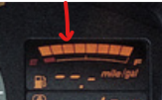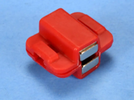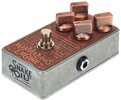You are using an out of date browser. It may not display this or other websites correctly.
You should upgrade or use an alternative browser.
You should upgrade or use an alternative browser.
How to improve MPG. Best mpg on st1300. Commuting
- Thread starter Nm767
- Start date
I think these only work if you also swap the engine oil for snake oil.Do fuel treatment magnets really work?
How fuel treatment magnets work
Basically, every one of these magnetic fuel saving devices is a magnet, a pair of magnets, or several magnets arranged in various configurations. The most common is a pair of magnets in a housing that clamps around the fuel line, with the magnets in an attracting arrangement, meaning opposite poles of the magnets are facing each other so the magnets want to come together. This configuration creates the strongest magnetic field possible through the fuel.
While we make no scientific claims about their use, several of us have tried this on various vehicles with varying degrees of success. On 4 of the 6 vehicles tested, the regular driver noted improved fuel mileage by 1/2 to 2 miles per gallon. Two of these say that it took about 2 months to notice improvement, which is a claim made by other manufacturers. In two of the vehicles, the driver reported no change in fuel mileage. Conclusive? Hardly. But it does make us believe that there is a possibility that strong magnetic fields may improve fuel mileage. We won't even speculate as to how or why this happens - we'll let all the specialists make their claims and tell you why it works.

Makes sense, and what I'll do next. Much of the differences on here could primarily be "computer" differences.Doing the math with mileage and fuel will tell the real story.
I did a fuel economy run in 1982 on my CB250RS and recorded 145 mpg; that involved a race crouch and being very gentle on the throttle, and was probably helped by my lesser mass in those days. The biggest factor was draughting in the rich blue fumes of a Suzuki GT750 two stroke (needless to say, HE didn't win the economy run).Ahhh...but it isn't necessarily that they are getting that much on "average". Those bars only mean what someone has gotten once. My own graph for my F800GT would show you I got over 74 mpg...once or twice. Most of the time in town, I got about 48 mpg. On the highway, I could count on 55-60 mpg. It all depended on how many stoplights I hit and how fast I was going. My current F900XR has gotten 95 mpg. I have no idea how that happened. But it shows in the Fuelly data.
Chris
Last edited:
Based on my instant fuel mileage read out (which I know resets every 15 seconds or so) the best mileage numbers I've ever seen for more than a mile at a time have actually been in 4th gear, not fifth, cruising at about 45 mph.
Now with my great weight and in the hilly area where I live, I can't be in fifth gear at 45 miles an hour unless I'm going downhill and even then I couldn't accelerate without badly lugging the engine, so that speed is a fourth gear proposition.
But the air resistance on my body and the bike is so low at 45MPH I get some crazy high temporary fuel economy numbers .
Now with my great weight and in the hilly area where I live, I can't be in fifth gear at 45 miles an hour unless I'm going downhill and even then I couldn't accelerate without badly lugging the engine, so that speed is a fourth gear proposition.
But the air resistance on my body and the bike is so low at 45MPH I get some crazy high temporary fuel economy numbers .
Don't count out snake oil. I installed one of these with a 1/4 inch adapter to the service check connector under the rear seat and am getting over 65 mpg. As an added bonus, it also automatically regulates windscreen height according to speed.I think these only work if you also swap the engine oil for snake oil.
Attachments
Wouldn't a flux capacitor work as well?Do fuel treatment magnets really work?
How fuel treatment magnets work
Basically, every one of these magnetic fuel saving devices is a magnet, a pair of magnets, or several magnets arranged in various configurations. The most common is a pair of magnets in a housing that clamps around the fuel line, with the magnets in an attracting arrangement, meaning opposite poles of the magnets are facing each other so the magnets want to come together. This configuration creates the strongest magnetic field possible through the fuel.
While we make no scientific claims about their use, several of us have tried this on various vehicles with varying degrees of success. On 4 of the 6 vehicles tested, the regular driver noted improved fuel mileage by 1/2 to 2 miles per gallon. Two of these say that it took about 2 months to notice improvement, which is a claim made by other manufacturers. In two of the vehicles, the driver reported no change in fuel mileage. Conclusive? Hardly. But it does make us believe that there is a possibility that strong magnetic fields may improve fuel mileage. We won't even speculate as to how or why this happens - we'll let all the specialists make their claims and tell you why it works.
Chris
only on a TeslaWouldn't a flux capacitor work as well?
Chris
Attachments
According to the display, I'm getting around 20 km/l. Or that's what I see whenever I'm moving and I can spare my eyes from the road to check it. I need to get more familiar with the buttons because I can read the average and the instantaneous consumption, and I think I'm reading the instantaneous value, and whenever I look at it while moving, it is when I'm riding straight without obstacles and steadily, so the readings are biased.
This is further confirmed by the fact that the fuel gauge is going down way faster than it should, according to the consumption. The bike is supposed to be able to run for even 500 km with a full tank. I filled it up recently, ran it for about 130 km, and the gauge is already saying there's only 3 ticks left.

It's true I've done quite a bit of urban riding lately, which will always have a much greater consumption.
I don't know what the Balance throttle bodies are about, though. I didn't check the valve clearances, so it could be that, but I'm crossing my fingers that's not the case because I can't get to it now.
A few years ago, I bought an old NT700, and the valves didn't get their service done. The engine performance (power and vibration) and consumption were significantly different after the service. This is a V4 engine, which is a whole different beast, but it feels so smooth that I find it hard to believe that the valves are not up to spec.
Lastly, I found the option to change between mpg and km/l. Is there an option to see it as l/100km?
This is further confirmed by the fact that the fuel gauge is going down way faster than it should, according to the consumption. The bike is supposed to be able to run for even 500 km with a full tank. I filled it up recently, ran it for about 130 km, and the gauge is already saying there's only 3 ticks left.

It's true I've done quite a bit of urban riding lately, which will always have a much greater consumption.
- Regarding the fuel
- Do you know if the consumption reading is accurate?
- Do you know if the fuel gauge is accurate?
- And on a more general note
- Is there a thread explaining all the buttons in the dash? There aren't many, but I'd like to confirm I know what they do. I checked the forum looking for "dash instructions" or similar keywords, but I couldn't find it.
- In addition to the buttons of the dashboard I just mentioned, are there other features that new users should be aware of? For example, the adjustable seat, the adjustable preload of the rear suspension, the ACC (accessories) position of the key, etc.
I don't know what the Balance throttle bodies are about, though. I didn't check the valve clearances, so it could be that, but I'm crossing my fingers that's not the case because I can't get to it now.
A few years ago, I bought an old NT700, and the valves didn't get their service done. The engine performance (power and vibration) and consumption were significantly different after the service. This is a V4 engine, which is a whole different beast, but it feels so smooth that I find it hard to believe that the valves are not up to spec.
Lastly, I found the option to change between mpg and km/l. Is there an option to see it as l/100km?
Last edited:
- Joined
- Oct 26, 2020
- Messages
- 2,059
- Location
- Makefield Highlands PA
- Bike
- 2016 ST1300P
- 2025 Miles
- 001084
According to the display, I'm getting around 20 km/l. Or that's what I see whenever I'm moving and I can spare my eyes from the road to check it. I need to get more familiar with the buttons because I can read the average and the instantaneous consumption, and I think I'm reading the instantaneous value, and whenever I look at it while moving, it is when I'm riding straight without obstacles and steadily, so the readings are biased.
This is further confirmed by the fact that the fuel gauge is going down way faster than it should, according to the consumption. The bike is supposed to be able to run for even 500 km with a full tank. I filled it up recently, ran it for about 130 km, and the gauge is already saying there's only 3 ticks left.
It's true I've done quite a bit of urban riding lately, which will always have a much greater consumption.
The fuel consumption I mentioned is significantly bigger than what I experienced with previous bikes, but they weren't this big, so maybe it's normal. The first 2 bullet points mention possible problems with the indicators rather than with the consumption itself because the bike feels good when riding. I just changed all the fluids and air filter, and I'd say the brakes are not dragging excessively. Also, I pumped the tires as indicated in the manual. The engine temperature reads OK as well, and the fans trigger when it gets too toasty. Idling speed feels good.
- Regarding the fuel
- Do you know if the consumption reading is accurate?
- Do you know if the fuel gauge is accurate?
- And on a more general note
- Is there a thread explaining all the buttons in the dash? There aren't many, but I'd like to confirm I know what they do. I checked the forum looking for "dash instructions" or similar keywords, but I couldn't find it.
- In addition to the buttons of the dashboard I just mentioned, are there other features that new users should be aware of? For example, the adjustable seat, the adjustable preload of the rear suspension, the ACC (accessories) position of the key, etc.
I don't know what the Balance throttle bodies are about, though. I didn't check the valve clearances, so it could be that, but I'm crossing my fingers that's not the case because I can't get to it now.
A few years ago, I bought an old NT700, and the valves didn't get their service done. The engine performance (power and vibration) and consumption were significantly different after the service. This is a V4 engine, which is a whole different beast, but it feels so smooth that I find it hard to believe that the valves are not up to spec.
Lastly, I found the option to change between mpg and km/l. Is there an option to see it as l/100km?
Article [13] - ST1300 - Owners Manual | ST1300 Articles
Owner's Manual supplied with new bikes.. NOT the service manual which is only purchased through Honda.
For what it is worth, my late friend, Morris Kruemke, of Texas long distance fame, I think he still holds the 48 state record at like 5.5 days, who had an engineering degree, told me that he revised a circuit in his gold wing so that when he was on cruise control at 80 mph, the fuel injection would lean out for greater mileage. I asked about burning out the motor, since I once put a dime sized hole in a Norton 750 piston and he told me he could lean that gold wing motor out to stop running and the engine would not suffer any damage. This is all I know and I am not in the technical knowledge range of most of the members in this forum.
ST Gui
240Robert
42-45 mpg. It seems to get 42 on regular and 45 on premium.
Same here, except I don't use Regular.
How to improve your mpg:
1. Remove the three sets of aux lights.
2. Remove hiway pegs
3. Remove car tire
4. Ditch the pillion
5. Empty your bags
6. Close your visor
7. Install Aeroflow windshield
8. Buy better gas
9. Seek a tail wind
1. Remove the three sets of aux lights.
2. Remove hiway pegs
3. Remove car tire
4. Ditch the pillion
5. Empty your bags
6. Close your visor
7. Install Aeroflow windshield
8. Buy better gas
9. Seek a tail wind
... and always ride downhill!How to improve your mpg:
1. Remove the three sets of aux lights.
2. Remove hiway pegs
3. Remove car tire
4. Ditch the pillion
5. Empty your bags
6. Close your visor
7. Install Aeroflow windshield
8. Buy better gas
9. Seek a tail wind

Balancing the throttle bodies refers to making adjustments to the starter valves so that the airflow in each inlet tract has the same vacuum; you need a set of vacuum gauges to do this, and it will affect the smoothness of the idle and have a small effect on the way the bike runs at very small throttle openings. I doubt that this would have any significant effect on fuel consumption.According to the display, I'm getting around 20 km/l. Or that's what I see whenever I'm moving and I can spare my eyes from the road to check it. I need to get more familiar with the buttons because I can read the average and the instantaneous consumption, and I think I'm reading the instantaneous value, and whenever I look at it while moving, it is when I'm riding straight without obstacles and steadily, so the readings are biased.
This is further confirmed by the fact that the fuel gauge is going down way faster than it should, according to the consumption. The bike is supposed to be able to run for even 500 km with a full tank. I filled it up recently, ran it for about 130 km, and the gauge is already saying there's only 3 ticks left.
It's true I've done quite a bit of urban riding lately, which will always have a much greater consumption.
The fuel consumption I mentioned is significantly bigger than what I experienced with previous bikes, but they weren't this big, so maybe it's normal. The first 2 bullet points mention possible problems with the indicators rather than with the consumption itself because the bike feels good when riding. I just changed all the fluids and air filter, and I'd say the brakes are not dragging excessively. Also, I pumped the tires as indicated in the manual. The engine temperature reads OK as well, and the fans trigger when it gets too toasty. Idling speed feels good.
- Regarding the fuel
- Do you know if the consumption reading is accurate?
- Do you know if the fuel gauge is accurate?
- And on a more general note
- Is there a thread explaining all the buttons in the dash? There aren't many, but I'd like to confirm I know what they do. I checked the forum looking for "dash instructions" or similar keywords, but I couldn't find it.
- In addition to the buttons of the dashboard I just mentioned, are there other features that new users should be aware of? For example, the adjustable seat, the adjustable preload of the rear suspension, the ACC (accessories) position of the key, etc.
I don't know what the Balance throttle bodies are about, though. I didn't check the valve clearances, so it could be that, but I'm crossing my fingers that's not the case because I can't get to it now.
A few years ago, I bought an old NT700, and the valves didn't get their service done. The engine performance (power and vibration) and consumption were significantly different after the service. This is a V4 engine, which is a whole different beast, but it feels so smooth that I find it hard to believe that the valves are not up to spec.
Lastly, I found the option to change between mpg and km/l. Is there an option to see it as l/100km?
How can you know what your real mpg are if you don't do the math. Displays are only an estimate. Get an accurate measurement over a couple of tanks and make note of city and highway miles. If you put around the block you mileage will be poor.
Balancing the throttle bodies refers to making adjustments to the starter valves so that the airflow in each inlet tract has the same vacuum; you need a set of vacuum gauges to do this, and it will affect the smoothness of the idle and have a small effect on the way the bike runs at very small throttle openings. I doubt that this would have any significant effect on fuel consumption.

Does Neil Degrasse Tyson know lots about ST1300s or are you just demonstrating your condescending attitude?
Share:




